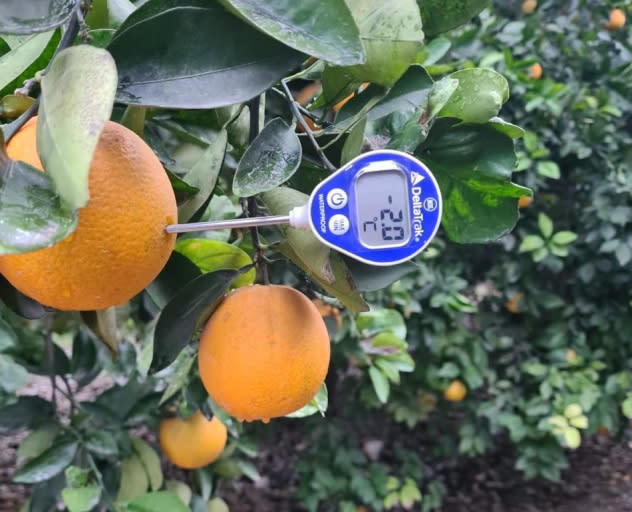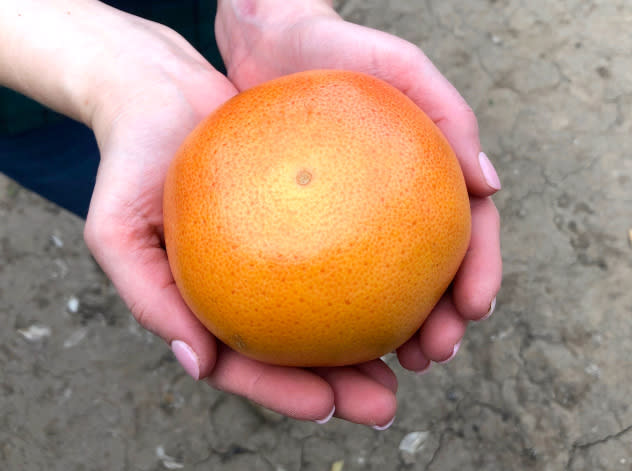Cold snap deep in Texas almost certainly means crop losses for citrus growers
The historic cold snap that has frozen Texas this week with brutal winter weather and brought snow all the way to beaches along the Gulf of Mexico is also bringing headaches for citrus growers at the southern tip of the state.
According to the USDA, Texas is the nation's third-largest citrus-producing state behind California and Florida. Dale Murden, president of Texas Citrus Mutual, a trade group that represents the interests of citrus growers in the state, told AccuWeather by email that growers were "about 50% harvested to date on grapefruit," when the brutally cold weather hit early this week, and were "just beginning to harvest our late Valencia orange."
"Most everyone saw temps of 21 degrees for several hours," Murden, who also is a grower, said. "We will no doubt lose some of the crop as we are seeing some ice buildup inside the fruit." Murden said that when temperatures dip below 28 degrees and stay below that mark for five hours or longer, the fruit that is still on branches begins to freeze on the inside.
Citrus groves in Texas are largely situated in the Lower Rio Grande Valley in parts of Hidalgo, Cameron and Willacy counties, Murden said. Several groves are located in Mission, a city of about 85,000 that is about 240 miles south of San Antonio, right along the border with Mexico. "Come and enjoy the warm weather," the city says on its website.
 |
Texas grapefruit trees encased in ice after a winter storm hammered the state with record cold. (Dale Murden) |
And, usually, the weather is warm there. In fact, just as recently as Wednesday of last week, the high temperature in Mission reached 85 degrees, which is more than 10 degrees above average for this time of year. By Friday, though, the temperature had crashed to a high of just 43, with a low in the 30s. And it only went down from there, bottoming out with an overnight low of 22 degrees on Feb. 15 as Arctic air continued pushing southward.
It wasn't just the unseasonable cold that was causing problems for growers. The wind also foiled growers' attempts to protect the fruit. "The wind was blowing so hard" on Sunday night, Murden said, that "most measures to warm trees up couldn't work."
April Flowers of Lone Star Citrus, a grower based in Mission, said there are a few different methods growers use to protect crops. "Some growers use a micro-jet irrigation system to spray their trees with water prior to the freeze because ice is insulative at 32 degrees," Flowers said, "but this type of system is expensive and not widely used."
Because the groves are spread over such a wide area, she said, "The best we can do is harvest as much as possible before a freeze."
 |
Growers take the temperature of an orange growing on a tree. (Dale Murden) |
But in Lone Star's case, "At this time we have about 15% of our crop hanging on the trees, and that is likely lost," Flowers said of the 6,000 acres Lone Star Citrus owns.
"We grow our citrus for the fresh market," Murden said, adding that 70% of the industry comprises red grapefruit and 30% is made up of various orange varieties. The Texas citrus industry also has some juicing operations, but juicing is mainly for the grapefruit and oranges that don't make the grade for the fresh fruit market, Murden explained.
As for whether this cold snap will turn into a weather disaster for Texas citrus growers, Murden said it's still too early to tell and will likely take a few weeks after the cold snap breaks for growers to assess any damages. He said growers are concerned as low temperatures are forecast to dip to 28 at night through Friday. Flowers echoed that point. "The next several weeks will give us a clearer picture of the true impact of the storm," she told AccuWeather.
 |
An example of a healthy, fresh-picked Texas grapefruit. (Lone Star Citrus) |
Any crop losses that are suffered will come after a weather disaster took a $100 million bite out of the state's citrus industry last July. The industry was hit hard by Hurricane Hanna, which was the first hurricane of a hyperactive 2020 season and made landfall in late July near Port Mansfield, Texas. It came ashore as a Category 1 storm with 90-mph sustained winds. Murden said the hurricane caused an estimated industry-wide loss of 25%. Lone Star Citrus lost about 20% of its crop, Flowers said.
Warmer weather is on the way though - according to the AccuWeather forecast, above-normal temperatures will return to the Lower Rio Grande Valley by Sunday and into next week as the Arctic air from the polar vortex retreats back to the north. As AccuWeather Senior Meteorologist Alex Sosnowski put it, "The weather tends to work in extremes."
Keep checking back on AccuWeather.com and stay tuned to the AccuWeather Network on DirecTV, Frontier, Spectrum, Fubo, and Verizon Fios.




